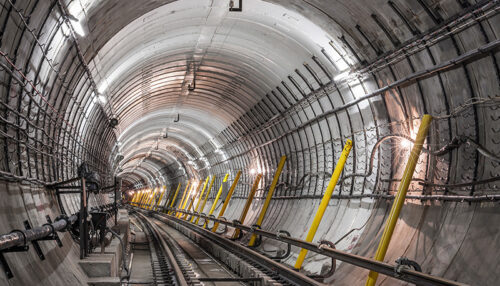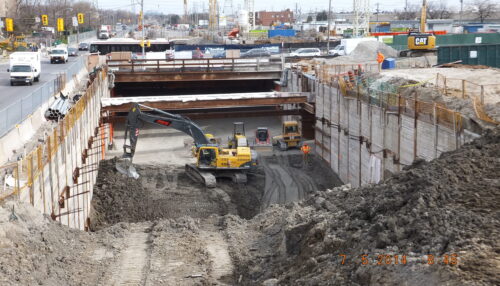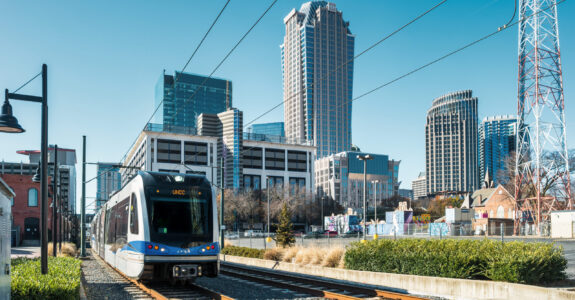
Sustainable Transit Development: Balancing Urban Progress and Environmental Stewardship
July 7, 2025
By: Kam Chan, P.Eng.
Urban transportation projects can transform communities, reduce emissions, and improve the quality of life for generations who will benefit from improved connectivity and access. However, these projects also bring challenges, including disruptions to residents’ daily routines and concerns related to construction activities like noise, detours, and air quality. In addition, transportation projects must navigate and comply with stringent environmental obligations to avoid legal challenges and other complications that can cause schedule delays. In this article, we draw on our experience with large, multi-year transit projects to highlight the advantages of embedding environmental stewardship within the project team from day one. We’ll explore the benefits of such an approach, including enhanced community goodwill, alignment with regulatory commitments, and improved efficiency. We’ll also discuss strategies for fully integrating environmental goals to unlock these benefits.
Building Community Trust through Transparency
One significant benefit of integrating environmental stewardship early in the pre-construction phase of a project is the inherent ability to enhance public and community support for the project. There is often strong community interest in learning about transformational construction projects. This was the case on the Finch West Light Rail Transit project (FWLRT) in Toronto, Ontario, Canada, where we were brought on by Mosaic Transit Group to lead and direct all environmental aspects of the project through the provision of an Environmental Director.
Through more than 140 outreach programs, meetings, and community engagement events, the project team built community trust through transparency by informing members of the community about construction progress and hiring and procurement opportunities available with Mosaic Transit Group. These sessions also gave our team a chance to provide education about specific environmental initiatives. Not all members of the community recognize the degree of planning and consideration of environmental factors that are built into these projects, so public education initiatives were focused on the tangible environmental protection measures such as onsite water management, erosion and sediment control, and dust and noise mitigation strategies. This education strategy proved essential in maintaining community engagement and goodwill throughout a transformative multi-year project.
Building and maintaining trust is also pivotal when working with Indigenous communities. By openly communicating comprehensive plans for protecting the environment throughout project development, proponents can find common ground with Indigenous communities whose traditional values emphasize respect for the natural environment and future generations.
By prioritizing transparency throughout the project lifecycle, construction teams can address concerns that often arise among stakeholders. Providing regular project updates to stakeholders fosters informed decision-making and increases community engagement, which ultimately increases community trust and support for the project.
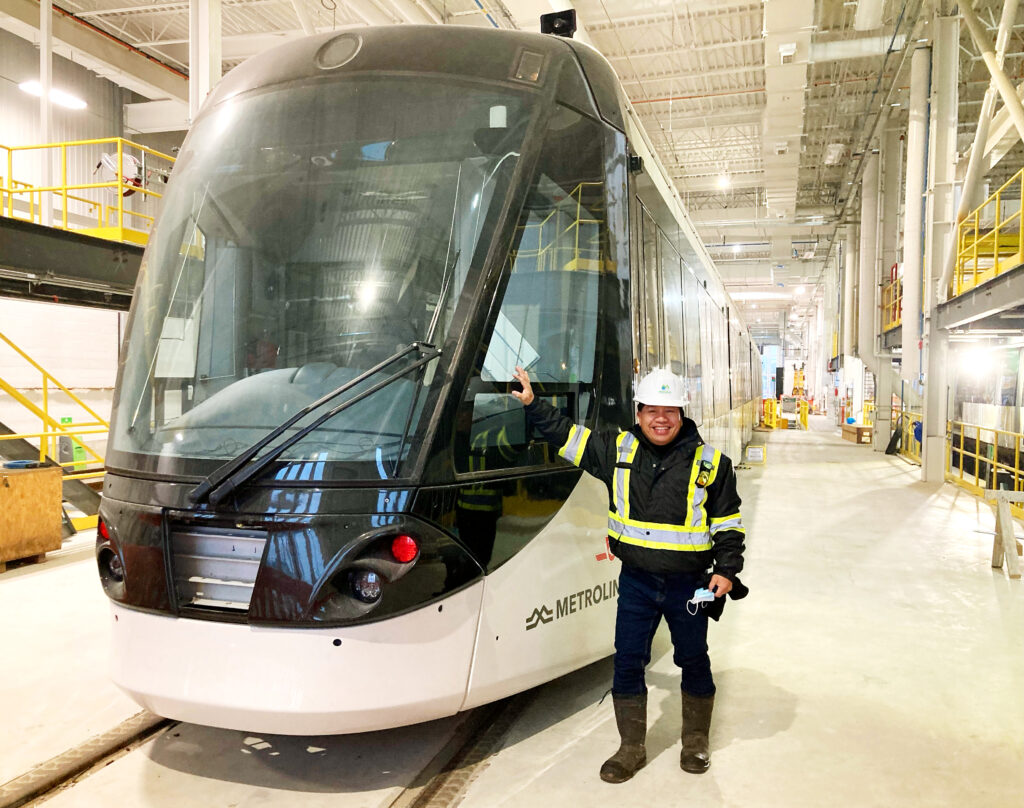
Montrose’s Arnie Fausto poses with a new light rail vehicle during construction of the Finch West LRT project in Toronto, Canada.
Aligning with Regulatory and Government Expectations
Although transit projects are typically constructed within highly urbanized areas, environmental stewardship is essential for meeting stringent regulatory obligations, stakeholder expectations, and protecting people and ecosystems. On the FWLRT project, the environmental mission of the project team was to minimize ecological disruption while magnifying the benefits of sustainable transit.
The integration of environmental stewardship aligns with the evolving regulatory expectations of government agencies for sustainable project development. Developing strong environmental management plans during the planning and permitting phase not only sets you up to meet project compliance requirements but also kicks off the relationship with regulators and stakeholders on a solid foundation. Projects that tangibly demonstrate sustainability considerations are also better positioned to receive funding and support while minimizing bureaucratic challenges.
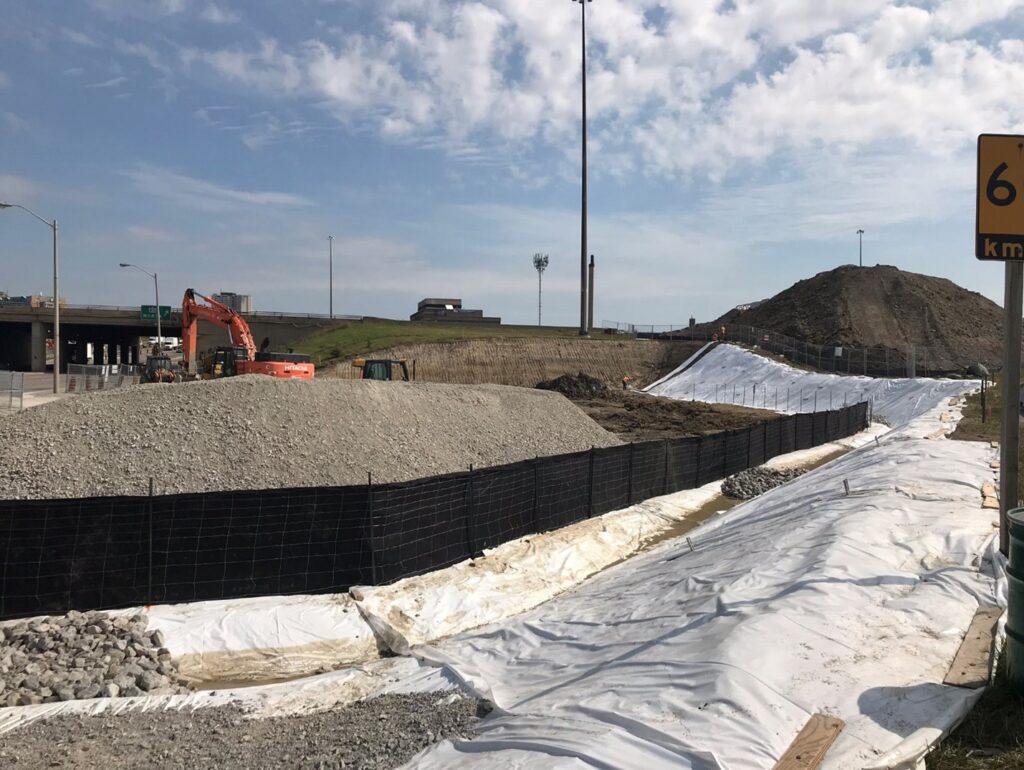
Installation of erosion and control measures along a highway interchange (design provided by Montrose)
Efficiency Benefits and Cost Savings
Incorporating environmental stewardship into project planning can lead to significant benefits for efficiency and cost savings. By addressing environmental concerns proactively, design and construction teams can minimize risks that might otherwise lead to project shutdowns and result in schedule delays. Environmental management plans also outline detailed response procedures for scenarios that could be encountered during construction. Avoiding delays hinges on an intimate understanding of these procedures, clarity on response roles, and being able to mobilize the right expertise quickly. This could mean bringing in wildlife biologists when a protected species is encountered on a construction route or mobilizing air quality monitoring systems in response to air quality concerns.
Another opportunity to gain project efficiency is through the reuse of natural project materials. On the FWLRT project, excess soil management plans were developed, meaning soil generated during construction could be reused as efficiently as possible, reducing the need to transport excess soil and disposal costs. A mix of creativity and precision is required when developing strategies to cut down on waste or unnecessary resource disruption.
Engaging a knowledgeable environmental team ensures that construction activities respect both operational realities and environmental obligations, facilitating a harmonious balance. This foresight can result in smoother operations and significant reductions in unforeseen expenses.
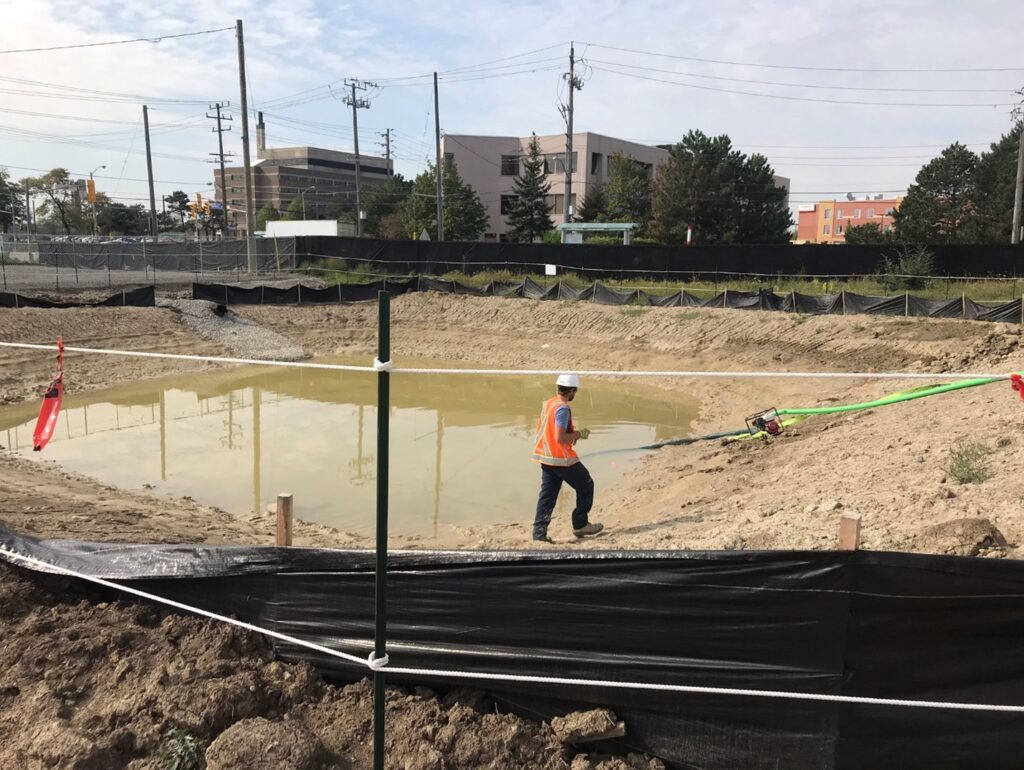
Temporary stormwater detention facilities designed to capture stormwater runoff from the construction site.
Strategies for Embedding Environmental Stewardship
To successfully embed environmental stewardship within a project, forming strategic partnerships from the beginning is essential. Given the complexity and multi-year effort required, secondments are common for key individual roles, such as Environmental Directors, to enhance collaboration, environmental oversight, and proactive management of risks. It also allows the Environmental Director to develop an intimate understanding of key project success factors and objectives. This partnership is critical in developing a comprehensive environmental management plan, which balances practical construction needs with environmental responsibilities.
As with any construction project, the preparation during pre-construction is critical. This stage includes development of meticulous environmental work plans tailored to the specific aspects of the project. Based on planned construction activities, an assessment is also performed to consider the likely and significant risks, followed by the creation of mitigation and response plans for those identified risks. Once construction activities begin, flexibility and responsiveness become essential. When it comes to environmental management, factors like spills, wildlife encounters, or public air quality concerns can develop. When they do, a prompt response is required to assess, mitigate, and adjust course as necessary to protect the environment and to keep construction timelines on track. Having access to a multidisciplinary response team is essential to effectively address any issues that arise in an efficient manner. You want to be able to pull in the right subject matter experts from across applicable disciplines like wildlife biology, soil and groundwater contamination and management, noise & vibration, and air quality when and as needed. Having a roster of integrated environmental specialists on standby increases peace of mind, knowing the project team can quickly respond to any environmental challenges that arise.
Key Takeaways and Actionable Advice
Embedding environmental stewardship into transportation construction projects is not only essential for compliance, but also a strategic advantage that promotes community trust and project efficiency. By prioritizing transparency, aligning with regulatory bodies, and fostering partnerships, project teams can better navigate risks and enhance overall outcomes. To maximize these benefits, project proponents should initiate stakeholder discussions early on, incorporate environmental expertise into project teams, and develop robust environmental management plans that cater to both regulatory needs and operational realities.
If you’re interested in learning more about implementing these strategies in your projects, please visit our Environmental Solutions for Infrastructure projects webpage. Together, we can harness the principles of environmental stewardship to create more successful transportation initiatives that benefit our communities.
Continue Reading
 Kam Chan, P.Eng.
Kam Chan, P.Eng.
Global Market Sector Leader – Infrastructure
Kam is a professional engineer and business leader with over 25 years of environmental engineering expertise, with a focus on infrastructure and environmental strategies. He has worked on multiple major infrastructure projects delivered under various procurement models, including public-private-partnerships (P3) and traditional design-build. He has a solid understanding of project environmental obligations and is passionate about delivering sustainable solutions and bringing environmental stewardship to the construction of transformational infrastructure projects. Kam instills strong partnerships to drive project success while recognizing that the infrastructure landscape continues to evolve.

